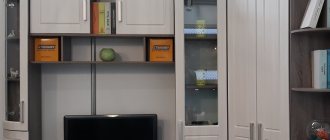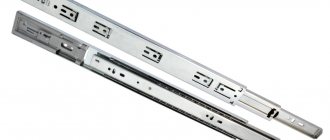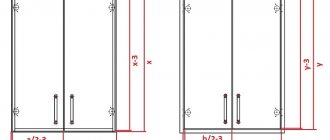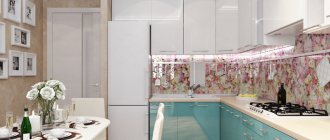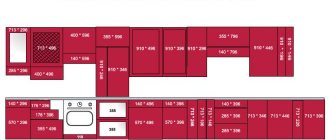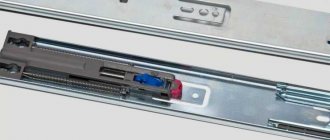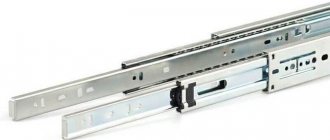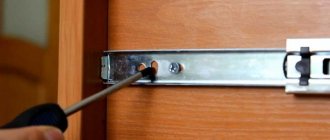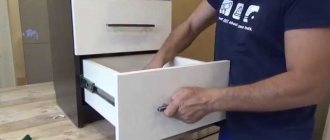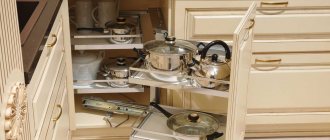Drawers, baskets, shelves are convenient, ergonomic storage places in wardrobes and dressing rooms. Retractable storage systems allow you to make the most efficient use of the interior space of the furniture, while all placed items of any size will always be “in sight” and available for search. But no matter what equipment option you choose, you will have to select the dimensions of the guides for the drawers, taking into account the nuances of installation and calculations of the dimensions of the parts, as well as the dynamic load on the mechanism.
Types of drawer guides
Any retractable mechanism of cabinet furniture is based on the operation of roller or ball guides.
Ball guides are also called “telescopic” or “telescopes” due to the principle of extending the inner part of the runners from the outer housing. They are slightly more expensive than roller ones.
ball (telescopic) guides for drawers
| Size range of ball guides, mm | ||||||
| 250 | 300 | 350 | 400 | 450 | 500 | 550 |
Roller guides are the simplest and cheapest extension mechanism: two plastic rollers slide along the slides, and when lifted into a small diagonal, they are easily removed from each other.
roller guides for drawers
| Dimensions of roller guides, mm | ||||||
| 250 | 300 | 350 | 400 | 450 | 500 | 550 |
Each of the two main types of guides has many varieties.
Retractable systems based on roller guides
For example, so-called metaboxes work on roller guides - retractable systems, which are metal sidewalls for drawers of different heights.
Metaboxes are also called metalboxes, samboxes. They can be equipped with longitudinal and transverse rails, expanded with blind and perforated inserts, and also supplemented with closers.
Most pull-out shelves and baskets for wall-mounted wardrobes and walk-in closets also roll out using a roller guide built into the hanging frame.
Retractable systems based on ball (telescopic) guides
There are also many varieties of telescopic retractable systems.
Ball guides for drawers are distinguished according to the installation method. There are overhead and mortise ones, as well as with hidden installation - in this case, the retractable mechanism is “hidden” under the bottom of the drawer box.
The system of moving the roller guides does not allow a closer to be built inside the mechanism - it can only be installed as a separate capsule and “slow down” the movement of the drawer. But ball guides with a built-in closer are implemented in a single mechanism.
Also, all roll-out baskets, cargo and other mesh storage systems with closers that ensure smooth “retraction” of the mechanism “work” due to ball guides.
Separately, it is worth highlighting the so-called tandemboxes - retractable systems with double-walled metal sides, inside of which there is a built-in ball guide with an additional “upgrade” that ensures silent smooth closing with a closer.
Tandem boxes are designed for increased load capacity; there are models with dynamic loads of up to 70-80 kg. For comparison, the load-bearing capacity of metaboxes on roller guides is about 20-30 kg.
Design and material of guide roller DS and MB
The presence of rubber-coated rollers, which ensure quiet running, is a false impression of the quality of the DS and MB guides.
There are two types of rubberized rollers: composite and solid.
- Composite ones
consist of two parts with a rubber gasket. - Solid
- with a longitudinal groove in which a rubber roller is located.
Previously, by using a rubber softening pad, the noise of the guides was reduced, but the use of rubber led to increased friction between the roller and the guide, as a result of which opening and closing the drawer was difficult and inconvenient. Such roller designs significantly reduced its wear resistance, consumer and operational properties of products, and the roller was destroyed. Modern DS and MB guides of high quality from well-known manufacturers use rollers made of POM polymer (polyoxymethylene), as well as rollers made of ABS plastic material.
- POM
(polyoxymethylene, polyformaldehyde, polyacetal) (—H2C—O—)n is a polymerization product of formaldehyde. It is characterized by high stability, maintains rigidity and mechanical strength up to 120°C, is resistant to abrasion, shock loads, organic solvents and oils. It is a self-lubricating material, resistant to low temperatures, which is important during transportation and storage in warehouses. - ABS plastic
is an impact-resistant technical thermoplastic resin based on a copolymer of acrylonitrile with butadiene and styrene (the name of the plastic is formed from the initial letters of the names of the monomers). It is characterized by high hardness and strength, resistance to impact loads.
Roller guides for drawers, dimensions for installation, nuances of choice
The dimensions of the roller guides for drawers and storage systems are selected according to the depth of the niche in which they are planned to be installed. In this case, the assembled box should be at least 10-20mm smaller in depth. For example, in a cabinet with sidewalls 420mm deep, guides 400mm long are selected.
The size range of roller guides for drawers is presented in sizes from 250mm to 550mm (rarely more, up to 600, 650 and 700mm) in increments of 50mm.
There are mounting holes along the entire length of the rails. The distance between them obeys the well-known rule for cabinet furniture, called “system 32”. Its essence lies in the multiplicity of distances for installation to the number 16/32 - 64, 96, 128, etc.
One part of the rail with a “corner” shape is attached to the drawer, with a grip on the bottom, and the second – to the inner side of the wardrobe.
When choosing roller guides for a drawer, it is important to take into account not only the length of the rails themselves, but also the quality characteristics of the mechanism itself:
- Metal thickness. The majority of breakdowns occur due to insufficient rigidity of the rails. Drawers fall out of their grooves, bending them with their weight. To prevent this from happening, when choosing, pay attention to the thickness of the metal. It is optimal for shallow (up to 300-350mm) and low (up to 200-250mm along the facade) drawers to choose roller guides with a thickness of 1mm. For everyone else - 1.2-1.5mm.
- Load bearing capacity. Roller guides for drawers are the most inexpensive mechanism on the market. Cheapness is also determined by the obviously low requirements for ride quality, weight loads, etc. The dynamic load on the roller mechanism should not exceed 10-20 kg, taking into account the weight of the box itself (depending on the size, a drawer can weigh 3-7 kg).
If you are planning to make drawers in a wardrobe or dressing room with a larger load and quite voluminous in size, it is better to choose an equipment option among ball pullout systems. They will last much longer and will not irritate you with harshness, squeaking and noise when moving.
Advantages of MB guides in comparison with DS guides
- The greater thickness of the metal in combination with a higher counter part allows you to increase the payload of the furniture box.
- The reinforced counter part of the MB guides allows the use of more massive facades from various materials for the production of furniture boxes, which makes it possible to create boxes with different front designs.
- The sufficient height of the counter part of the MB guides makes it possible to install an eccentric mechanism for adjusting the facade on it, which allows you to adjust the position of the facade in height in the range of ±2 mm.
Ball guides for drawers, dimensions for installation, nuances of choice
In terms of quality characteristics, ball mechanisms are much better: they are more stable, durable, provide smooth movement of the drawer and are almost silent. But they also cost a little more.
The good news is that the calculation of drawer frame dimensions for roller and ball slides is exactly the same. The size of the gap between the box frame and the sides for both types is 12.5-13mm.
That is, you can always change the roller guides to telescopic (ball) ones if for some reason you are not satisfied with the quality of the first ones.
The exception is mortise guides and hidden installation: the technological dimensions of the gaps between the box frame and the sides are calculated differently for them. In size, the hidden-mounted drawer is larger in width, and the gaps between the sidewalls and the box are smaller (by internal size -49mm versus -90mm when calculated).
There is also a difference in the installation of ball guides on a drawer: if the roller guides “cling” under the bottom, then the ball guides - along the center of the side.
The dimensions of ball guides for drawers according to the installation holes also follow the “32 system”.
When choosing ball guides for a drawer, pay attention to the size, metal thickness and load-bearing capacity of the mechanism. Thin telescopic mechanisms are more designed for installing pull-out shelves with low and medium loads. More “powerful”, wider in size are suitable for deep chest of drawers up to 900mm wide.
The design of the drawer and its internal contents can also vary in size and functionality. You can read about this here.
Paint quality (including color consistency) for DS and MB guides
High-quality painting is achieved by following the following technology:
- Preliminary preparation of the surface before painting: mandatory degreasing, removing the oil film and the natural oxidized layer of the metal
- Painting: only the use of professional enamel and automated painting equipment can provide a high-quality, uniform and uniform layer of paint on the product, including uniform painting of all recesses without smudges.
- Drying in a special chamber at a certain temperature for a strictly controlled time.
- DS guides are available in white (W), brown (Br), black (Bl) and gray (GR).
- MB guides are produced in white (W) and gray (GR) colors.
Stylistic directions and colors
In modern layouts, built-in furniture is more common, which makes the interior complete and harmonious. In addition to clear functionality, it must be beautiful and stylish. For each type, you can use any option. Among the variety of styles, the following directions are chosen for kitchens:
- Provence. Homely warmth and comfort, a variety of indoor flowers make the room spacious and light. Light colors and natural materials in decoration and furniture predominate.
- Classic. The discreet, functional style does not accept intrusive elements. The space in the kitchen is planned rationally, each item has its own purpose. The characteristic color range is all shades of brown, from light beige to dark brown.
- Country. Built-in appliances are hidden in cabinets and behind the facades, furniture and a dining table with a patina effect. The rustic style will only look true with a lot of textiles. There must be linen curtains, rugs, pillows on sofas and chairs. Light colors and natural materials are used for decoration.
- Modern. No decor, only the most necessary items. A practical, comfortable interior with strict lines can be decorated in any color. The main thing is complete harmony of tones and the presence of warm lighting.
- High tech. As much glass and metal as possible. The kitchen is filled with electrical appliances using the latest technology. Only clear lines and respect for proportions. The color scheme is expressed in two colors - one primary, the second additional.
Corner kitchen: pros and cons
Pros of a corner kitchen:
- suitable for both a spacious studio kitchen and a small kitchen;
- due to the maximum use of space, there will be no such problem as a lack of space for kitchen utensils, household appliances or food storage;
- the compact arrangement of furniture will significantly save space and allow you to additionally mark out any furniture or appliances, for example, a built-in dishwasher or oven;
- the used corner can be equipped for a sink, in addition, additional space will appear inside the cabinets, and household items can be placed on the countertop;
- The look of the L-shaped set is an excellent stylistic solution for any interior.
A corner kitchen is a convenient option for a small space, as well as a solution that allows you to implement the most daring ideas in a large area.
Disadvantages of a corner kitchen:
- cabinet doors can touch adjacent ones when opened and thereby leave defects;
- seams and joints that, in a humid environment, can become susceptible to mold and mildew over time.
